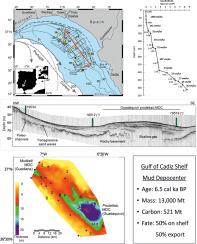Sedimentary Geology ( IF 2.7 ) Pub Date : 2021-06-10 , DOI: 10.1016/j.sedgeo.2021.105956 Till J.J. Hanebuth , Mary Lee King , Francisco J. Lobo , Isabel Mendes

|
Mud depocenters (MDCs) are common elements on modern continental shelves and act as a major shallow-marine sink for fluviogenic material. These most proximal depocenters, thus, play a major role in material cycling and carbon availability on global and regional scales, though individual formation history, dependence on external forcing mechanisms, and material composition makes each of them a unique case. This study establishes a chronostratigraphic framework and deciphers the depositional dynamics for the two main MDCs on the continental shelf in the eastern Gulf of Cadiz, as a prime example, with the goal to calculate a regional sediment and carbon budget. Based on the analysis of 2040 km of subbottom profiles and 18 sediment cores, the fine-grained depocenters began to grow during maximum flooding around 6.5 cal ka BP. Sedimentation rates ranged between 2 and 35 cm/ka until 2.7 cal ka BP and increased significantly around the Roman Warm Period (30–200 cm/ka), caused by regional humidification as well as mining and agricultural activities. After 1.0 cal ka BP, sedimentation rates rose further (20–3000 cm/ka), due to land clearing in coincidence with erosion-favoring aridity during the Islamic period and the Medieval Climate Anomaly. Unprecedented sediment accumulation started with the Industrial Era. The total sediment volume of the two MDCs is 5.80 km3 with a dry mass of 12,971 Mt. 85 Mt of organic matter and 3637 Mt of carbonate make this depocenter an important shallow-marine sink, with a total of 521 Mt carbon as a significant player in the regional terrestrial-marine carbon cycle.
中文翻译:

加的斯湾全新世陆架泥沉积中心的形成历史和物质收支
泥浆沉积中心 (MDC) 是现代大陆架上的常见元素,是河流生成物质的主要浅海汇。因此,这些最近的沉积中心在全球和区域范围内的物质循环和碳可用性方面发挥着重要作用,尽管个体形成历史、对外部强迫机制的依赖以及物质组成使它们中的每一个成为独特的案例。本研究建立了年代地层框架并破译了加的斯湾东部大陆架上两个主要 MDC 的沉积动力学,作为一个典型的例子,目的是计算区域沉积物和碳收支。根据对 2040 公里的底层剖面和 18 个沉积岩心的分析,细粒沉积中心在 6.5 cal ka BP 附近的最大洪水期间开始增长。沉降率在 2.7 cal ka BP 之前介于 2 到 35 cm/ka 之间,并且在罗马暖期 (30-200 cm/ka) 附近显着增加,这是由区域增湿以及采矿和农业活动引起的。在 1.0 cal ka BP 之后,由于土地清理与伊斯兰时期的侵蚀性干旱和中世纪气候异常同时发生,沉积速率进一步上升(20-3000 cm/ka)。前所未有的沉积物堆积始于工业时代。两个 MDC 的总沉积量为 5.80 km 由于土地清理与伊斯兰时期有利于侵蚀的干旱和中世纪气候异常同时发生。前所未有的沉积物堆积始于工业时代。两个 MDC 的总沉积量为 5.80 km 由于土地清理与伊斯兰时期有利于侵蚀的干旱和中世纪气候异常同时发生。前所未有的沉积物堆积始于工业时代。两个 MDC 的总沉积量为 5.80 km3干重 12,971 吨。85 Mt 的有机质和 3637 Mt 的碳酸盐使这个沉积中心成为重要的浅海汇,共有 521 Mt 的碳是区域陆地 - 海洋碳循环的重要参与者。











































 京公网安备 11010802027423号
京公网安备 11010802027423号